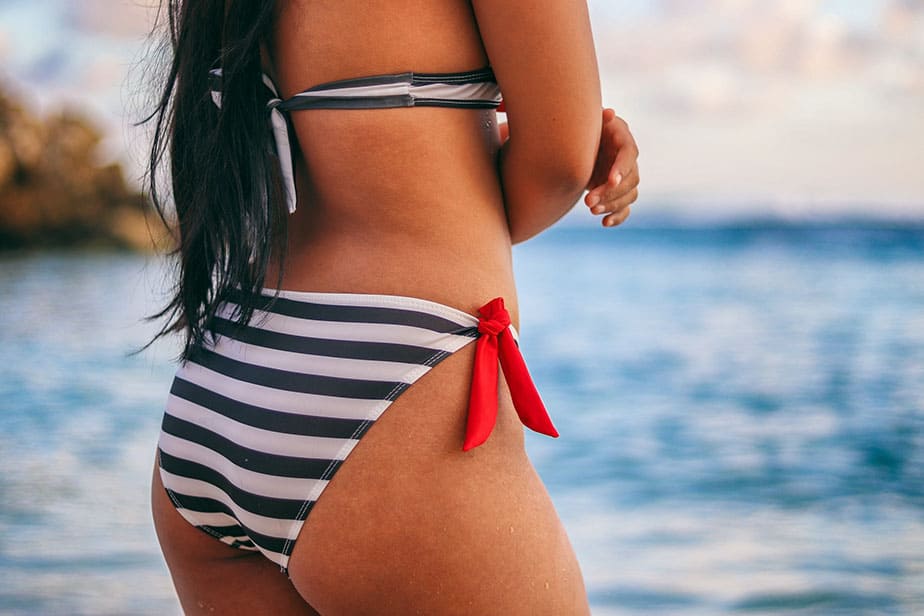Tell me if this sounds familiar to you. You got a new bikini recently and are excited to try it on at the beach for the first time. After exiting the water and lounging around the beach for a while, you notice that people are staring more than usual.
You attribute this attention to how good you look in your new bikini. You got guy after guy coming up to you and chatting you up, asking if you’ve been in the water yet, how great you look, making all kinds of idle talk, using this as an excuse to get close and stare you up and down. Eventually you brush them off.
That’s when you start to notice that not just men, but other women and parents are staring at you. The difference is, they are giving you dirty looks. That’s strange, you start to think; are these people just jealous of how much attention I’m getting from the boys?
Then it hits you. You go to a nearby bathroom and look into the mirror. Shock and horror. You knew the new bikini would show off your great figure, but you didn’t expect it to be this revealing. It was difficult to tell in the store, but now that your bikini is wet, it’s painfully clear that your bikini is actually see-through. From the time you got out of the water until now, everybody was able to get a clear view of your entire body as if you were naked.
For some people, they are excited at the prospect of this happening. They love the attention they get from being exhibitionists. For others, this is the most embarrassing possible thing that could happen to them and they would rather not repeat this mistake. That is what this article aims to help you with.
How do you fix a see-through bikini bottom? Unless you have the sewing skills to add lining yourself, or you are willing to wear another layer of fabric underneath to conceal your private parts, the easiest solution is to simply buy another pair of bikini bottoms. This time around, you should learn how to discern whether a swimsuit is see-through or not so that you don’t accidentally show off the goods to everyone.
Keep reading on, and we will go over how you can shop for a bathing suit that is not see-through. This can be tricky since you are not able to wear it into the water before you buy it, and returns are not accepted once it’s been worn into the water, so follow our tips to ensure you don’t make these common mistakes.
How to avoid see-through bathing suits

The problem with buying swimsuits is that you often cannot get an accurate representation of how it will look and feel in the water. Some swimsuits will ride up, stretch out, or become see-through. This section will provide tips on how to discern if a swimsuit will become see-through and how to find one that isn’t.
Do a stretch test
A simple test to determine if a swimsuit is sheer or not that is surprisingly effective is to press your fingers against the swimsuit and stretch the fabric. By stretching it against your fingers, you are simulating what it’s like when it’s pressed firmly against your body. If your fingers are already visible at this stage, you know it’s going to be totally see-through when wet. Put it back on the rack.
What’s great about this test is that it’s quick and can be done on swimsuits right off the rack. It will save you a lot of time because you don’t even need to take it to a changing room and put it on. That said, the obvious downside is that it doesn’t simulate what the swimsuit will be like when it’s wet, but it does weed out any obviously thin swimsuits.
Look for a darker color or a patterned print
Avoid lighter colors, especially white, unless you are sure the material is thick enough to not become see-through and cover up your private bits when soaked. That said, darker colored swimwear or swimwear with prints on it do a great job of not only obscuring your body, but also any stains.
Look for thicker materials
Dealing with this see-through issue is a lot easier if you know which materials are opaque even when wet. If you have a swimsuit made with a thicker, more durable material, you could even wear a white swimsuit and feel confident that you are not exposing more than you intended.
The most commonly used fabrics that swimsuits are made of are nylon and spandex, or a combination of the two. These materials are known for being lightweight and stretchable that provides a skin-tight fit while also being quick to dry. That said, this strength becomes an issue if the material is too thin, and that tends to be the case for cheaper swimsuits that use less fabric to cut costs.
Sometimes you need to pay a premium to get ahead, and in this case, a more expensive swimsuit will not only last longer, but it will keep you covered up the whole time. Cheaper swimsuits will thin out much faster and become see-through, forcing you to replace them much faster, not saving you much money, if any at all, in the long run.
Look for swimsuits with lining (or add them yourself)
To ensure the swimsuits are thick enough to cover up your body, many swimsuits will have an inner lining. This is effectively an extra layer specifically designed to cover up your most private parts so that they do not become see-through when wet. If a swimsuit doesn’t have any lining inside, it will probably become see-through.
If your swimsuit does not have lining inside, you can try to sew it on yourself if you have the skills. Take a look at this video below to get an idea of the kinds of lining fabrics that can be used for your swimsuit.
There are lots of videos on YouTube and guides you can look up online with detailed instructions on how you can add lining to your own swimsuit, so give those a look if you are up for doing some DIY.
Similarly, you could take some old bra cups and cut it into a triangular shape. Take this shape and insert it into the seam located on your bikini bottom. This will at least cover up your lips and prevent instances of camel toe.
Avoid sheer swimwear
If you see swimwear marketed as “sheer”, avoid them! Otherwise, it’s your own fault for wearing swimsuits that do exactly what they are designed to do.
Wear a cover up
This doesn’t solve the problem per se, but it does… cover it up. Literally. When you’re in the water, people probably can’t tell if your swimsuit is see-through or not. The main problem is when you’re back on land. The easy solution, then, is to wear a cover up so that your private parts are covered up.
Anything can be a cover up; you don’t specifically need to buy a special beach cover up for some fun in the sun. You should always bring a cover up with you regardless, just because they provide so much sun protection and allow you to enter public areas without changing out of your bathing suit.
Do people even care if you’re wearing see-through bottoms?
Obviously this depends on the context, as being very revealing at a nude beach won’t draw any attention compared to other situations. If you’re at a family function, that’s pretty cringeworthy unless your whole family are nudists and very body positive.
If you’re just at a (non-nude) beach, then as a woman, you will get a lot of positive attention from guys. If anyone is going to take offense, it’s usually other women who see you as a rival, and parents who don’t want their kids seeing a woman’s private parts.
Most of the time, people will give you the benefit of the doubt and assume you just had a wardrobe malfunction. If anyone actually gets angry at you, you have some plausible deniability. That said, you probably truly want to prevent having your swimwear become see-through and aren’t doing it on purpose, but that’s about what you should expect in most contexts.
If you really don’t want to have see-through bottoms, consider implementing the tips discussed in this article the next time you go shopping for a bathing suit. If you have some sewing skill, you might even be able to add an inner lining to your old swimwear so that they are no longer see-through when wet.

